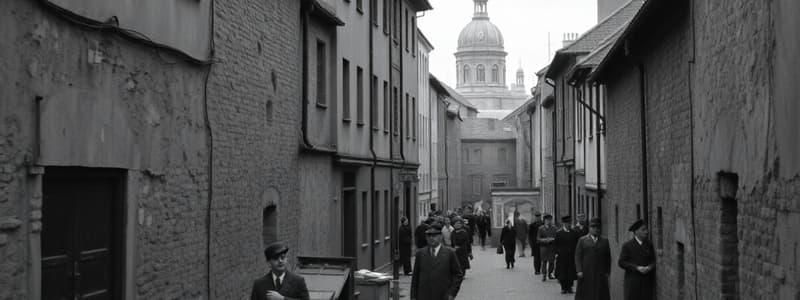Podcast
Questions and Answers
What was the nature of the entrance to the Wassertorstrasse, as described?
What was the nature of the entrance to the Wassertorstrasse, as described?
- A grand boulevard lined with government buildings.
- A wide, open marketplace bustling with activity.
- A big stone archway, a bit of old Berlin, daubed with hammers and sickles and Nazi crosses (correct)
- A modern, well-maintained plaza with various shops.
According to the description, what was a common scene in the courtyard of the Berlin ghetto?
According to the description, what was a common scene in the courtyard of the Berlin ghetto?
- Political rallies and public speeches denouncing the government.
- Street singers and musicians performing for an audience in the clammy autumn weather. (correct)
- Children playing organized games under the supervision of adults.
- Lavish banquets and celebrations by the wealthy residents.
How did the Jewish tailor and outfitter in the Berlin ghetto typically conduct his business?
How did the Jewish tailor and outfitter in the Berlin ghetto typically conduct his business?
- He bartered goods and services with other residents of the ghetto.
- He operated a large, well-stocked store with many employees.
- He primarily catered to wealthy clients outside the ghetto.
- He sold clothes of all kinds on the installment plan. (correct)
What activity did the Jewish tailor undertake daily to earn a living?
What activity did the Jewish tailor undertake daily to earn a living?
What event marked the beginning of Germany's official persecution of the Jews?
What event marked the beginning of Germany's official persecution of the Jews?
What were German soldiers doing outside of businesses on April 1, 1933?
What were German soldiers doing outside of businesses on April 1, 1933?
What types of businesses were owned by successful Jews in Germany after World War I?
What types of businesses were owned by successful Jews in Germany after World War I?
What was a significant factor that led millions of Jews to flee Russia and Eastern Europe in the late 1800s?
What was a significant factor that led millions of Jews to flee Russia and Eastern Europe in the late 1800s?
What was a primary reason Jewish tailors and small business owners were often confined to ghettos?
What was a primary reason Jewish tailors and small business owners were often confined to ghettos?
What action did the German government take that marked the beginning of official persecution?
What action did the German government take that marked the beginning of official persecution?
How did the economic status of successful Jews in Germany compare to other wealthy Germans after World War I?
How did the economic status of successful Jews in Germany compare to other wealthy Germans after World War I?
What was the general economic condition of the majority of Jews living in Russia and Eastern Europe in the late 1800s?
What was the general economic condition of the majority of Jews living in Russia and Eastern Europe in the late 1800s?
What was a consequence of German soldiers standing outside Jewish-owned stores?
What was a consequence of German soldiers standing outside Jewish-owned stores?
Why were Jewish tailors and small-business viewed as unwelcome competitors?
Why were Jewish tailors and small-business viewed as unwelcome competitors?
What was the general atmosphere in the courtyard of the Berlin ghetto?
What was the general atmosphere in the courtyard of the Berlin ghetto?
What did German soldiers shout outside of Jewish businesses?
What did German soldiers shout outside of Jewish businesses?
What motivated the millions of Jews to leave Russia and Eastern Europe?
What motivated the millions of Jews to leave Russia and Eastern Europe?
How did the Jewish tailor described in "Goodbye to Berlin" earn his living?
How did the Jewish tailor described in "Goodbye to Berlin" earn his living?
What was the significance of the date April 1, 1933?
What was the significance of the date April 1, 1933?
What was the result of the persecution of Jewish people in Europe?
What was the result of the persecution of Jewish people in Europe?
Flashcards
Berlin's Jewish Ghetto
Berlin's Jewish Ghetto
Area in Berlin characterized by poverty and anti-Jewish sentiment.
April 1, 1933
April 1, 1933
Day marking the start of official persecution; German soldiers boycotted Jewish businesses.
Post-WWI Jewish Success
Post-WWI Jewish Success
Many successful Jews moved into upper classes and owned major industries.
Late 1800s: Jewish Flight
Late 1800s: Jewish Flight
Signup and view all the flashcards
Ghetto Confinement
Ghetto Confinement
Signup and view all the flashcards
Study Notes
- The entrance to the Wassertorstrasse was a big stone archway, a part of old Berlin, marked with hammers, sickles, Nazi crosses, and bills advertising auctions or crimes.
Life in the Ghetto
- The streets were shabby and cobbled, with children's tears.
- In the courtyard, street singers and musicians performed continuously in the clammy autumn weather, with parties of boys with mandolins, a concertina player, and a singing father.
- A Jewish tailor and outfitter regularly visited, selling clothes on the installment plan and collecting pfennigs to make a living.
Persecution Begins
- On April 1, 1933, German soldiers stood at the entrances of department stores and shops, urging customers to stay away, shouting, "This is a Jewish business!"
- There was a call to boycott Jewish businesses.
- Few customers entered, and few stores remained open.
- This day marked the beginning of Germany's official persecution.
Jewish Success and Flight
- After World War I, many Jews moved into the upper class, owning steel mills, railroads, shipping lines, department stores, and banks.
- Wealthy Jews' lives closely resembled those of wealthy Germans.
- For every upper-class Jew, there were dozens of middle and working-class Jews.
- Beginning in the late 1800s, millions of Jews fled the impoverished villages in Russia and eastern Europe, some to the United States.
- Jewish tailors and small-business owners were often confined to ghettos in central European cities because they were viewed as unwelcome competition.
Studying That Suits You
Use AI to generate personalized quizzes and flashcards to suit your learning preferences.





